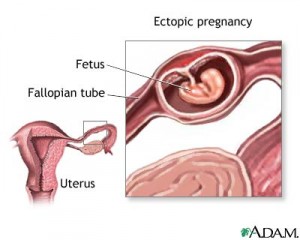Feb
21
Let’s get right to it…
 In previous posts, I’ve explained how all evidence indicates that, when a human male and female conceive, the unborn zygote/blastocyst/embryo/fetus is not only a living, individual entity distinct from the woman — either biological mother or gestational surrogate — carrying it, but a fully human one, at that. (The same would still be true, of course, even if fertilization occurred in a petri dish or “test tube”.) I have also argued that the reasons given for allowing elective abortion of the unborn are not morally sufficient, since humans are intrinsically valuable from conception by virtue of what they are — i.e., human.
In previous posts, I’ve explained how all evidence indicates that, when a human male and female conceive, the unborn zygote/blastocyst/embryo/fetus is not only a living, individual entity distinct from the woman — either biological mother or gestational surrogate — carrying it, but a fully human one, at that. (The same would still be true, of course, even if fertilization occurred in a petri dish or “test tube”.) I have also argued that the reasons given for allowing elective abortion of the unborn are not morally sufficient, since humans are intrinsically valuable from conception by virtue of what they are — i.e., human.
But, I also indicated that there are rare exceptions in which it might be morally justified to abort a pregnancy. (Go here to read what I said about pregnancies resulting from incest and rape.) Continuing on that topic, let’s look at the third suggested circumstance which even many pro-lifers agree should be an exception to the rule. Often, this exception is phrased as being when there is a threat to the life, or even just the “health”, of the mother. Unfortunately, this has become a weasel-phrase that is expanded to mean not just physical health but emotional/psychological health, which is further broadened to mean just about any stress, annoyance, disappointment, or hardship — real or imagined. Thus, a mother can elect to have an abortion because being pregnant “freaks her out” or puts added pressure on her to get a job or she’s “just not ready.” (See excerpt from Roe v. Wade below.)
“A study of motivations for abortion has found that the majority are sought for socioeconomic reasons. Women seeking abortions seldom give the real reason for doing so to investigators studying the issue…. At times medical considerations enter into the picture, but decisions are usually made on the basis of such factors as desire or lack of desire for parenthood, stability of relationships, educational status, emotional status, or economic status, among others.” — Dr. Warren Hern, Abortion Practice (1984), cited in The Case for Life
Are these really legitimate reasons for ending the life of… well, anyone? Absolutely not.
This is why pro-lifers want any laws addressing this to specify that it is the mother’s life that truly must be in danger from the pregnancy or from giving birth, not merely something vague called “health”. Of course, medical methods and technology are constantly improving, such that the number of actually life-threatening situations for mother or child are relatively rare and decreasing all the time. Even pregnant women with cancer can often be treated with chemotherapy with little danger to the unborn within. But there are times when the life of the mother or child or both are threatened, and difficult decisions must be made.
Take a tubal or ectopic pregnancy (EP), for instance. This is a condition in which the zygote(?) implants somewhere other than on the uterine wall, usually within the fallopian tube. (Perhaps as many as 1 in 40 pregnancies are ectopic.) If allowed to continue developing, the “embryo” will outgrow the fallopian tube or wherever it is, causing massive hemorrhaging and serious internal damage. There is no way the developing human child can come to term. Even with today’s medical technology, s/he cannot be safely transplanted elsewhere. And, if the EP gets to the point where the mother dies from internal bleeding, the embryo dies, too.
 So,… what to do? Is there a morally clear answer?
So,… what to do? Is there a morally clear answer?
Yes. The mother’s life can, of course, be saved by either chemical or surgical intervention — i.e., removing/destroying the embryo. But, at this stage, the embryo cannot survive, no matter what. Do nothing, and you will likely have two human deaths. Abort, and you only have one. In order to achieve the greatest moral good, we do what we can to save the most lives. In this case, that means acting to save the mother’s life, even though the unintended and unavoidable consequence is the death of the human embryo. Pro-life advocates agree: it’s better to save one life than to lose two.
Another situation may arise with a condition called pre-eclampsia (aka toxemia), which affects roughly 5-8% of pregnancies. The ultimate cause is unclear, but this complication seems to develop from poor blood flow in the placenta due to an insufficient network of blood vessels deep in the wall of the uterus. It is usually diagnosed from very high blood pressure after at least 20 weeks gestation, protein in the urine, headaches, belly pain, and other possible symptoms. If caught early on, the symptoms may be ameliorated and the danger reduced with proper treatment — e.g., drugs to lower the mother’s BP and/or to help the baby’s lungs mature.
If pre-eclampsia is diagnosed after symptoms have progressed too far — the speed of which varies — or not at all, the mother is at risk for liver, kidney, and/or brain damage. A severe case could result in tonic-clonic seizures (i.e., eclampsia), which are fatal in ~2% of cases. Meanwhile, if the fetus doesn’t get enough blood & oxygen, its growth & proper development can be seriously affected, the placenta could detach from the uterine wall too early (i.e., placental abruption, which can be deadly for both mother and child), and there is the very real risk of stillbirth.
According to eMedicineHealth.com,
“Complications resulting from high blood pressure, preeclampsia, and eclampsia may account for up to 20% of all deaths that occur in pregnant women.”
The only “cure” for pre-eclampsia is to remove the unborn from his/her mother — either by inducing labor or performing a cesarean delivery, depending on severity of symptoms and the relative health of mother and child. In some cases, this effectively means an abortion, though it may not be fair to call it that. The intent is not to destroy the fetus, but to save as many lives as possible. Modern technology keeps pushing back the point at which a premature baby can be saved. (Currently around 24 weeks, though with high incidence of major disabilities.) So, if otherwise healthy enough, s/he may survive with special care. But, the risk that the premature baby may die must be taken, in order to save the mother’s life. If the child is not removed in these severe cases, s/he will (almost?) certainly die anyway, as the mother’s condition worsens, possibly to the point of her own death.
Other potentially life-threatening situations may occur when it is not a foregone conclusion that the embryo or fetus will die, anyway. Sometimes, it is possible to save the unborn child, but doing so puts the mother’s life at risk — or, it may even be virtually guaranteed to kill her. At this point, a choice must be made about which life to save. Two precious human lives are at stake, but only one can be saved. So, how does one decide who lives and who dies? I can’t imagine the agony of being in the position of needing to make that decision. But, having established that both lives are intrinsically valuable, it is now ethically acceptable to consider “functional” worth.
The mother is an established individual in society, known and loved by family, friends, maybe other associates. If she has a job, she has value to her employer and co-workers. If she is involved in church or other organizations, she has value due to her contributions there. You get the idea. The unborn child, on the other hand, has none of this. S/he hasn’t had the opportunity to do any of that. But, the mother has. If she dies, her loss will be MUCH more strongly felt, and by more people, than if the unborn child dies. Family and friends will grieve the loss of the child but not nearly so much as they would the loss of the woman they know and value for who she is and what she contributes to their lives. So, hard as it would be to do, most agree that saving the mother at the expense of her unborn child would be the “greater good.” Still, the maternal instinct is very strong, and some mothers elect to sacrifice themselves in order to give their child the opportunity to live. (I once saw this dramatized on an episode of ‘ER’. Heart-wrenching!)
Being involved in any of these situations is very difficult, and feelings of guilt, anger, frustration, moral confusion, etc., are common. This is why it is a good idea to have thought through these issues beforehand, when you can have a measure of objectivity. I hope these posts have helped. If so, you may want to print them out, so you have them for later reference.
For more information on bioethics, abortion, and making the pro-life case, consider any books/resources by Scott Klusendorf, Scott B. Rae, Francis J. Beckwith, Robert P. George, or Greg Koukl.
—–
Found in Section VIII of Roe v. Wade decision (italics added by me):
“This right of privacy, whether it be founded in the Fourteenth Amendment’s concept of personal liberty and restrictions upon state action, as we feel it is, or, as the District Court determined, in the Ninth Amendment’s reservation of rights to the people, is broad enough to encompass a woman’s decision whether or not to terminate her pregnancy. The detriment that the State would impose upon the pregnant woman by denying this choice altogether is apparent. Specific and direct harm medically diagnosable even in early pregnancy may be involved. Maternity, or additional offspring, may force upon the woman a distressful life and future. Psychological harm may be imminent. Mental and physical health may be taxed by child care. There is also the distress, for all concerned, associated with the unwanted child, and there is the problem of bringing a child into a family already unable, psychologically and otherwise, to care for it. In other cases, as in this one, the additional difficulties and continuing stigma of unwed motherhood may be involved. All these are factors the woman and her responsible physician necessarily will consider in consultation.”
















